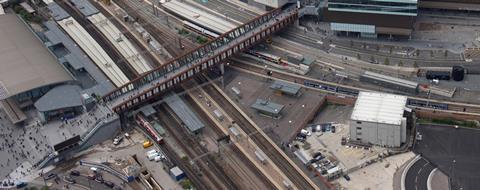
UK: London Waterloo has lost its place as the busiest station in Great Britain after 17 years at the top of the table, according to the Office of Rail & Road’s latest estimates of annual station usage.
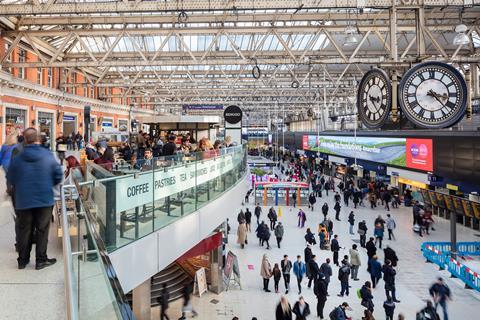
A total of 2 569 stations in Great Britain were served by mainline rail services as of March 31 2021. However, the coronavirus pandemic meant only 388 million rail journeys were made in the year between April 2020 and March 2021. This was 22% of the 1·74 billion journeys made in 2019-20 and the lowest patronage since before the time series began in 1872.
The busiest station in 2020-21 was Stratford in east London, which recorded 13 985 162 entries and exits. Waterloo saw the biggest decrease in passenger usage, with 12·2 million entries and exits compared to 86·9 million in 2019-20.
| 20 busiest stations in Great Britain | |||
|---|---|---|---|
| Station | Entries and exits | ||
| 2020-21 | 2019-20 | Change % |
|
| Stratford (London) | 13 985 162 | 41 912 114 | -67% |
| London Victoria | 13 791 322 | 73 559 158 | -81% |
| London Bridge | 13 763 890 | 63 095 300 | -78% |
| London Waterloo | 12 214 626 | 86 903 518 | -86% |
| London Liverpool Street | 11 212 008 | 65 984 786 | -83% |
| Highbury & Islington | 8 660 736 | 29 398 624 | -71% |
| Clapham Junction | 8 370 706 | 28 892 348 | -71% |
| Birmingham New Street | 7 350 942 | 46 510 526 | -84% |
| Barking | 6 742 918 | 13 831 488 | -51% |
| East Croydon | 6 695 420 | 25 005 626 | -73% |
| London Euston | 6 606 698 | 44 776 804 | -85% |
| London Paddington | 6 391 896 | 44 871 096 | -86% |
| London St Pancras International | 6 363 252 | 36 040 080 | -82% |
| Leeds | 5 853 754 | 31 020 744 | -81% |
| Canada Water | 5 576 276 | 21 797 466 | -74% |
| London Charing Cross | 5 373 056 | 29 138 398 | -82% |
| Glasgow Central | 5 325 090 | 32 465 202 | -84% |
| Manchester Piccadilly | 5 188 066 | 32 198 704 | -84% |
| Vauxhall | 4 986 700 | 19 997 264 | -75% |
| London Kings Cross | 4 667 820 | 32 532 404 | -86% |
Only five stations had more than 10 million entries and exits during the year, compared with 43 stations in 2019-20.
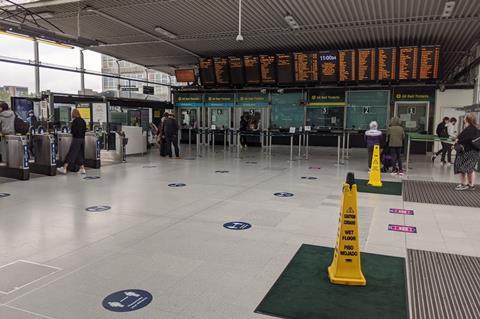
Highbury & Islington (8·7 million), Clapham Junction (8·4 million), Barking (6·7 million) and East Croydon (6·7 million) entered the top 10 for the first time, replacing the London termini at Paddington, Euston, St Pancras International and King’s Cross.
Birmingham New Street was the only station outside London that recorded more than 6 million entries and exits, with a total of 7·4 million. Liverpool Lime Street (3·5 million) and Cambridge (2·3 million) entered the list for the top 10 most used stations outside of London, replacing Gatwick Airport and Glasgow Queen Street.
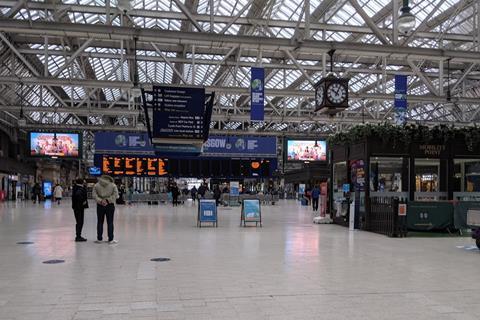
Glasgow Central was the most used station in Scotland (5·3 million, down from 32·5 million), while Cardiff Central remained the busiest station in Wales with just under 2 million entries and exits compared to more than 12 million last year.
ORR found 59 stations with less than 100 recorded entries and 18 stations with less than 20. Six stations recorded no entries or exits. In some cases, services had been temporarily suspended during to the pandemic, although the regulator notes that some journeys to or from these stations could have been made without a ticket.
| Stations with no recorded entries and exits in 2020-21 |
|---|
| Abererch |
| Beasdale |
| Llanbedr |
| Sampford Courtenay (services suspended in September 2019) |
| Stanlow & Thornton |
| Sugar Loaf |
The biggest percentage increase in use was at Berney Arms, which saw 348 entries or exits compared to 42 the previous year, when it was affected by engineering works. ORR noted that ‘highlighting the least used stations within these statistics can encourage people to visit them.’
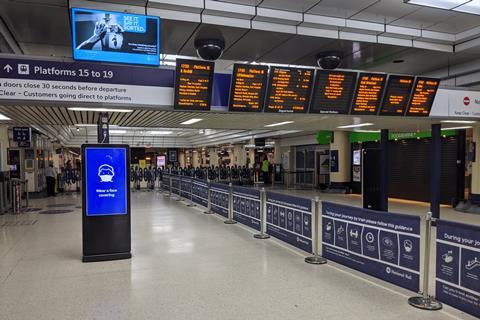
Commenting on the figures, Andy Bagnall, Director General at the Rail Delivery Group, said, ‘the rail industry kept people moving for the first year of the pandemic. Some of the entries on the list reflect where people like key workers were travelling from and also the acceleration of changes to how people are travelling after the pandemic. Rail companies are working together to welcome people back and the recent increase in passengers continues to both reflect and support the nation’s recovery.’



